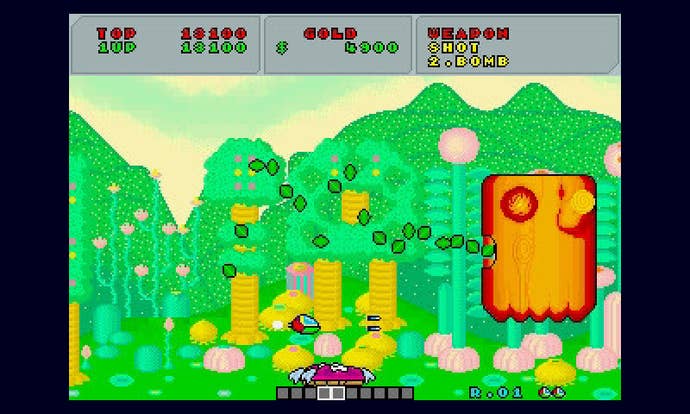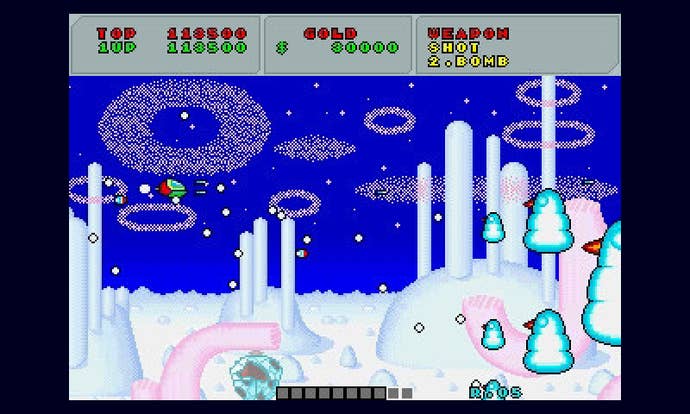Virtual Spotlight: 3D Fantasy Zone, Proof That Someone Out There Loves You
And that someone is M2.
This article first appeared on USgamer, a partner publication of VG247. Some content, such as this article, has been migrated to VG247 for posterity after USgamer's closure - but it has not been edited or further vetted by the VG247 team.
Last week's USgamer Community Question asked you, our readers, to name the best developer currently working in the games industry. The USG staff didn't answer, of course, so as not to play favorites.
But, if you were to put a gun to my head and demand I come up with my own answer, I might just have to say M2. Most gamers haven't heard of this little studio, and for good reason. They don't make many original games — the only ones that come to mind are Castlevania: The Adventure Rebirth and Gradius Rebirth, two easily forgotten WiiWare titles from about five years ago — instead focusing on remakes and compilations of classic games. That alone doesn't make M2 great, though. Lots of developers port classics to modern systems, and they don't always do a good job of it. For M2, however, quality is job one.
The idea of cycle-accurate emulation is all the rage these days (that is, not just approximating the functions of a console, but emulating each and every detail of the motherboard) but it requires far more power than the 3DS has. M2's projects for that system, such as their Game Gear Virtual Console and Sega 3D Ages arcade and Genesis remakes, can't get that granular or precise. So instead, M2 strives for a more experiential approach.
The appeal of M2's work comes from the fact that they don't simply emulate games; they try above all else to emulate what it was like to play those games. They're people who have strong memories of the classic days of the arcade; people for whom those memories continue to resonate; people who hope to share that love with other fans of those games. You may not be able to own a classic Super Hang On sit-down bike-style machine, but M2 will do its damnedest to recreate the feel of playing that cabinet to the best of their ability within the limited confines of a system like the Nintendo 3DS.
When it comes to something like Fantasy Zone, however, the particulars of what made the game experience so unique become a little fuzzier than with more elaborate Sega cabinets like Out Run or After Burner. It was your typical coin-op upright, just a step or two ahead of its eventual home conversion to Sega Master System, nothing particularly unusual by the standards of the mid-'80s. So M2's remake, 3D Fantasy Zone, lacks the wacky accelerometer tricks of some of their other games. Its presentation format comes down to crisp 2:1 pixel upscaling, a horrible full-screen stretched mode for people who like to pretend they have glaucoma while gaming, and a fun distorted mode that imitates the rounded corners and pinched visuals of an old CRT monitor — nice, but nothing particularly revolutionary.

Instead, M2's enhancements for this remake center more around actual in-game play mechanics than around the physical ephemera of its original format. While less conceptually impressive, they speak of a deep understanding of the original game... and they greatly increase its play value as well.
It helps, of course, to understand precisely what the original Fantasy Zone was all about. Sega's 1986 was arguably the first "cute-'em-up" — a side-scrolling shooter that was one part Defender, one part Candy Land. With its pastel graphics and soft, adorable enemies, it lacked the heavy metal edge that typifies most shooters. It wasn't about teenage angst or biotechnical grotesqueries or manly men reeking of testosterone... it was simply about whimsical fun, made lively by the upbeat FM synthesis audio that Sega loved so much back in the day.
Despite looking roughly as menacing as the Easter bunny, though, Fantasy Zone didn't lack for teeth. The game wasted no time ramping up the difficulty to make players sweat, and it offered considerable substance to go alongside its challenge. Rather than taking place in a fixed-scrolling space, Fantasy Zone instead let players scroll left and right at their own leisure in an infinite loop populated by enemy bases that disgorged a constant stream of smaller enemies. With the bases destroyed, a boss would appear for a more traditional fixed fight in which protagonist Opa-Opa could only face to the right; defeating that boss would allow players to progress to the next stage.

Where Fantasy Zone's additional depth came into play was with the inclusion of a free-floating shop in each stage where players could buy temporary upgrades with the money they collected from fallen foes. From better engines to 1UPs to alternate weapons, these goodies allowed for a certain degree of customization, similar to Wonder Boy II or any number contemporary Capcom action titles. The economy also added an interesting risk-reward element to the game; while it was relatively easy to simply shoot through the enemy masses to advance to the next stage, the coins they dropped literally dropped, plummeting to the ground below to be collected. Do you simply plow through the bad guys, or do you take the time and the risk to go after the coins? And which goodies do you buy with the cash? This simple gameplay conundrum lent Fantasy Zone considerably more staying power than your average shooter.
And it's this conundrum that serves as the basis for 3D Fantasy Zone's underlying improvements as well. Besides the display mode choices, a huge array of game options, and of course the addition of 3D layers effects to the side-scrolling elements of the action stages, M2 has also made the coin-collecting a fundamental meta-game element that extends beyond the bounds of a single credit.

The money you have on-hand when you die is credited to a permanent pool of cash. This bank of funds serves a couple of functions: If you manage to save up a million coins (then two million... then three) you'll unlock different features, including an alternate character with a different play style. You can also choose to "cash in" your coins at the beginning of a new game, starting at any previously conquered stage with a bunch of money in-hand for instant shopping spree gratification. This reminds me a little bit of the weapon storage mechanic in Shiren the Wanderer, and it comes with the same risk — you can sink hours into storing up cash only to wipe it all out in a matter of minutes with an unlucky run.
The addition of a "budget" to the game's larger framework creates a new dynamic for the included arcade title. You can take the straightforward approach, sure, but you can also budget for the future, or cash in your chips and beef up Opa-Opa from the very outset to completely destroy everything in your path. It's a subtle and sophisticated touch that adds a lot to what amounts to a simple shoot-em-up.
But then, that's M2 in a nutshell. This could have been a simple port, but instead the developers have gone in and rethought the fundamental mechanics of Fantasy Zone in a way that complements the experience. It's fleshed-out yet faithful, entertaining as a twitch shooter but featuring enough additional depth to give players a reason to continue playing.
VisualsWonderfully pastel and perfectly suited to the 3D gimmick. The one downside is how easily the pale yellow coins disappear against the backgrounds.
SoundVintage '80s FM synth, reproduced to perfection. Wonderful.
InterfaceAs always, M2 has lavished ridiculous detail on what could have been a throwaway port, making it worth the asking price.
Lasting AppealMore than just a 30-year-old shooter, 3D Fantasy Zone offers ample replay value. Not that you need an excuse to revisit this classic, but the additional factors really help.
Conclusion3D Fantasy Zone demonstrates its developers' commitment to offering the best possible classic game experience. It lends new dimension to this old shooter, and not just in the literal sense. My only frustration with this game and the series as a whole is that Sega seems to monopolize M2's talents, when their wonderful approach to classic game preservation should be a gift the entire world can enjoy. But kudos to Sega for continuing to treat their back catalog with such reverence.








